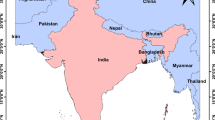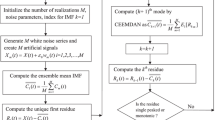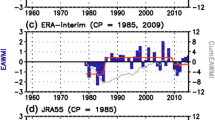Abstract
Previous studies in the literature show that the annual cycle of surface air temperature (SAT) is changing in both amplitude and phase, and the SAT departures from the annual cycle are long-term correlated. However, the classical definition of temperature anomalies is based on the assumption that the annual cycle is constant, which contradicts the fact of changing annual cycle. How to quantify the impact of the changing annual cycle on the long-term correlation of temperature anomaly variability still remains open. In this paper, a recently developed data adaptive analysis tool, the nonlinear mode decomposition (NMD), is used to extract and remove time-varying annual cycle to reach the new defined temperature anomalies in which time-dependent amplitude of annual cycle has been considered. By means of detrended fluctuation analysis, the impact induced by inter-annual variability from the time-dependent amplitude of annual cycle has been quantified on the estimation of long-term correlation of long historical temperature anomalies in Europe. The results show that the classical climatology annual cycle is supposed to lack inter-annual fluctuation which will lead to a maximum artificial deviation centering around 600 days. This maximum artificial deviation is crucial to defining the scaling range and estimating the long-term persistence exponent accurately. Selecting different scaling range could lead to an overestimation or underestimation of the long-term persistence exponent. By using NMD method to extract the inter-annual fluctuations of annual cycle, this artificial crossover can be weakened to extend a wider scaling range with fewer uncertainties.










Similar content being viewed by others
References
Barbosa SM (2009) Changing seasonality in Europe’s air temperature. Euro Phys J Spec Top 174(1):81–89
Bunde A, Ludescher J, Franzke C, Büntgen U (2014) How significant is West Antarctic warming? Nature Geosci 7:246–247
Bye J, Fraedrich K, Schubert S, Zhu X (2013) The changing length of the warming period of the annual temperature cycle in the high latitudes under global warming. Atmos Ocean 51(3):309–318
Capparelli V, Vecchio A, Carbone V (2011) Long-range persistence of temperature records induced by long-term climatic phenomena. Phys Rev E 84(4):046103
Chen X, Lin G, Fu Z (2007) Long-range correlations in daily relative humidity fluctuations: a new index to characterize the climate regions over China. Geophys Res Lett 34(7):L07804. doi:10.1029/2006GL027755
Eichner JF, Koscielny-Bunde E, Bunde A, Havlin S, Schellnhuber HJ (2003) Power-law persistence and trends in the atmosphere: a detailed study of long temperature records. Phys Rev E 68(4):046133
Eliseev AV, Mokhov II (2003) Amplitude-phase characteristics of the annual cycle of surface air temperature in the Northern Hemisphere. Adv Atmos Sci 20(1):1–16
Franzke C((2010) Long-ranged ependence andc limaten oisec haracteristics of Antarctict emperatured ata. J Clim 23:6074–6081
Franzke C (2012) On the statistical significance of surface air temperature trends in the Eurasian Arctic region. Geophys Res Lett 39:L23705. doi:10.1029/2012GL054244
Franzke C (2013) A novel method to test for significant trends in extreme values in serially dependent time series. Geophys Res Lett 40:1391–1395. doi:10.1002/grl.50301
Govindan RB, Kantz H (2004) Long-term correlations and multifractality in surface wind speed. EPL 68(2):184
Graves T (2013) A systematic approach to Bayesian inference for long memory processes. Diss. University of Cambridge
Graves T, FranzkeC, WatkinsN, GramacyR, Tindale E (2017) Systematic Bayesian inference of the long-range dependence and heavy-tail distribution parameters. Phys A 473:60–71
Hu K, Ivanov PCh, Chen Z, Carpena P, Stanley HE (2001) Effect of trends on detrended fluctuation analysis. Phys Rev E 64:011114
Iatsenko D, McClintock PV, Stefanovska A (2015) Nonlinear mode decomposition: a noise-robust, adaptive decomposition method. Phys Rev E 92(3):032916
Jones PD, Briffa KR, Osborn TJ (2003) Changes in the Northern Hemisphere annual cycle: implications for paleoclimatology? J Geophys Res 108(D18):1551–1564
Kantelhardt JW, Koscielny-Bunde E, Rego HH, Havlin S, Bunde A (2001) Detecting long-range correlations with detrended fluctuation analysis. Phys A 295(3):441–454
Koscielny-Bunde E, Bunde A, Havlin S, Goldreich Y (1996) Analysis of daily temperature fluctuations. Phys A 231(4):393–396
Koscielny-Bunde E, Bunde A, Havlin S, Roman HE, Goldreich Y, Schellnhuber HJ (1998) Indication of a universal persistence law governing atmospheric variability. Phys Rev Lett 81(3):729
Kurnaz ML (2004a) Application of detrended fluctuation analysis to monthly average of the maximum daily temperatures to resolve different climates. Fractals 12(04):365–373
Kurnaz ML (2004b) Detrended fluctuation analysis as a statistical tool to monitor the climate. J Stat Mech 2004(07):P07009
Lennartz S, Bunde A (2009) Trend evaluation in records with long-term memory: Application to global warming. Geophys Res Lett 36(16):287–295
Li Q, Fu Z, Yuan N, Xie F (2014) Effects of non-stationarity on the magnitude and sign scaling in the multi-scale vertical velocity increment. Phys A 410:9–16
Lin G, Chen X, Fu Z (2007) Temporal–spatial diversities of long-range correlation for relative humidity over China. Phys A 383(2):585–594
Ludescher J, Bunde A, Franzke C, Schellnhuber HJ (2016) Long-term persistence enhances uncertainty about anthropogenic warming of West Antarctica. Clim Dyn 46:263–271
Mann ME, Park J (1996) Greenhouse warming and changes in the seasonal cycle of temperature: Model versus observations. Geophys Res Lett 23(10):1111–1114
Massah M, Kantz H (2016) Confidence intervals for time averages in the presence of long-range correlations, a case study on Earth surface temperature anomalies. Geophys Res Lett 43:9243–9249. doi:10.1002/2016GL069555
Mokhov II (1985) Method of amplitude-phase characteristics for analyzing climate-dynamics. Soviet Meteor Hydr 5:14–23
Monetti RA, Havlin S, Bunde A (2003) Long-term persistence in the sea surface temperature fluctuations. Phys A 320:581–589
Paluš M, Novotná D, Tichavský P (2005) Shifts of seasons at the European mid-latitudes: natural fluctuations correlated with the North Atlantic Oscillation. Geophys Res Lett 32(12):161–179
Peng CK, Buldyrev SV, Havlin S, Simons M, Stanley HE, Goldberger AL (1994) Mosaic organization of DNA nucleotides. Phys Rev E 49(2):1685
Qian C, Zhang X (2015) Human influences on changes in the temperature seasonality in mid- to high-latitude land areas. J Clim 28(15):5908–5921
Qian C, Fu C, Wu Z (2011a) Changes in the amplitude of the temperature annual cycle in China and their implication for climate change research. J Clim 24(20):5292–5302
Qian C, Wu Z, Fu C, Wang D (2011b) On changing El Niño: a view from time-varying annual cycle, interannual variability and mean state. J Clim 24(24):6486–6500
Schreiber T, Schmitz A (2000) Surrogate time series. Phys D 142(3):346–382
Stine AR, Huybers P (2012) Changes in the seasonal cycle of temperature and atmospheric circulation. J Clim 25(21):7362–7380
Stine AR, Huybers P, Fung IY (2009) Changes in the phase of the annual cycle of surface temperature. Nature 457(7228):435–440
Talkner P, Weber RO (2000) Power spectrum and detrended fluctuation analysis: application to daily temperatures. Phys Rev E 62(1):150
Thomson DJ (1995) The seasons, global temperature and precession. Science 268(5207):59
Thomson DJ (1997) Dependence of global temperatures on atmospheric CO2 and solar irradiance. Proc Natl Acad Sci USA 94(16):8370–8377
Varotsos C, Kirk-Davidoff D (2006) Long-memory processes in ozone and temperature variations at the region 60S–60 N. Atmos Chem Phys 6(12):4093–4100
Vecchio A, Carbone V (2010) Amplitude-frequency fluctuations of the seasonal cycle, temperature anomalies, and long-range persistence of climate records. Phys Rev E 82(6):066101
Vecchio A, Capparelli V, Carbone V (2010) The complex dynamics of the seasonal component of USA's surface temperature. Atmos Chem Phys 10(19): 9657–9665
Vyushin DI, Fioletov VE, Shepherd TG (2007) Impact of long-range correlations on trend detection in total ozone. J Geophys Res 112:D14307. doi:10.1029/2006JD008168
Wallace CJ, Osborn TJ (2002) Recent and future modulation of the annual cycle. Clim Res 22(1):1–11
Wu Z, Schneider EK, Kirtman BP, Sarachik ES, Huang NE, Tucker CJ (2008) The modulated annual cycle: an alternative reference frame for climate anomalies. Clim Dyn 31:823–841
Yuan N, Fu Z (2014) Century-scale intensity modulation of large-scale variability in long historical temperature records. J Clim 27(4):1742–1750
Yuan N, Fu Z, Mao J (2010) Different scaling behaviors in daily temperature records over China. Phys A 389(19):4087–4095
Yuan N, Ding M, Huang Y, Fu Z, Xoplaki E, Luterbacher J (2015) On the long-term climate memory in the surface air temperature records over Antarctica: an onnegligiblef actor fort rende valuation. J Clim 28(15):5922–5934
Acknowledgements
This study is funded by the National Natural Science Foundation of China (No. 41675049).
Author information
Authors and Affiliations
Corresponding author
Rights and permissions
About this article
Cite this article
Deng, Q., Nian, D. & Fu, Z. The impact of inter-annual variability of annual cycle on long-term persistence of surface air temperature in long historical records. Clim Dyn 50, 1091–1100 (2018). https://doi.org/10.1007/s00382-017-3662-5
Received:
Accepted:
Published:
Issue Date:
DOI: https://doi.org/10.1007/s00382-017-3662-5




